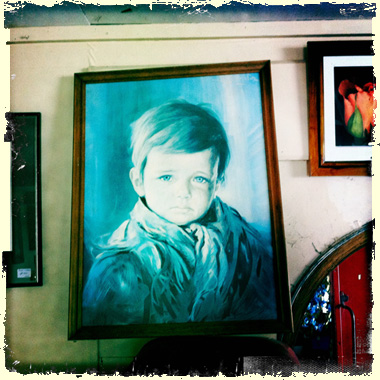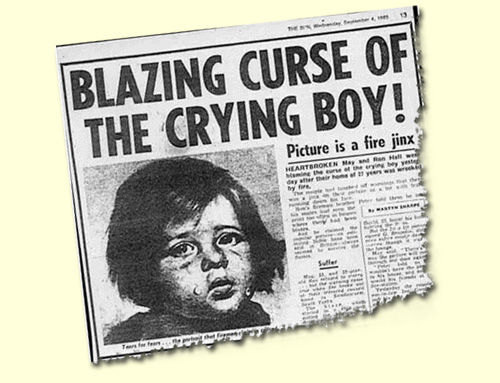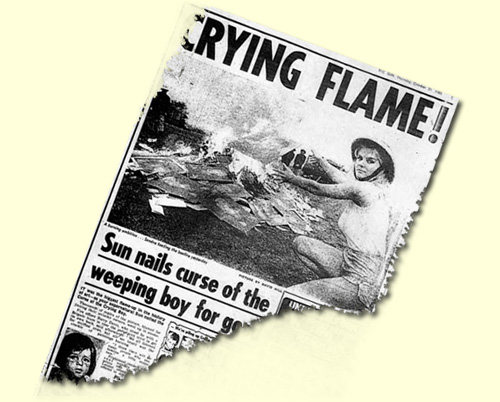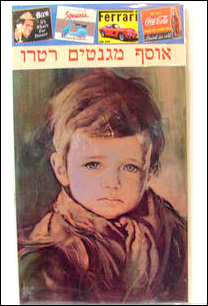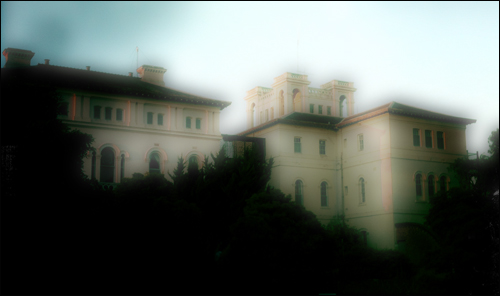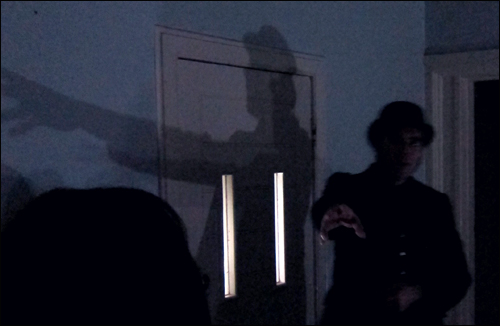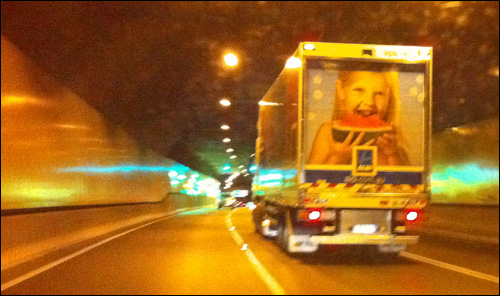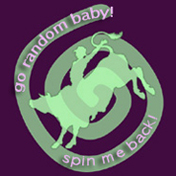Mon 1 Dec 2014
The One That Got Away
Posted by anaglyph under Australiana, Creepy, Hmmm..., Photography, Skeptical Thinking, Spooky
[16] Comments

Just prior to Halloween, my friend Hugh wrote to me with a very spooky tale. It seems that a neighbour of his – let’s call her Margaret – had recently been on a ‘ghost’ tour of a popular historical location in Sydney, and had been involved in a quite unsettling experience. You will recall that I am not averse to the occasional ghost tour, so I was very interested to hear his account of Margaret’s adventure.
The particular locale in question runs several kinds of tours: straight historical tours, ‘ghostly encounter’ tours, ghostly sleepovers, and ‘extreme’ ghost tours. I believe that Margaret and her daughter attended one of the ‘ghostly encounter’ tours – an adult walking tour taken by lantern light and featuring moderately ‘spooky’ content.
Margaret told Hugh that the significantly creepy part of her tour occurred in a dormitory in one of the buildings that was on the evening’s itinerary. This is how Hugh described the incident in an email:
Last Saturday she and her daughter went on a night ghost tour of [a heritage site]. ((Names and locations have been anonymised by arrangement with Hugh))
She said the place had a very sad feel to it. Not of danger, or anger, but sorrow.
The touring party entered one of the old dormitories, and a number of them posed on the beds, feigning illness. Margaret felt this was disrespectful, so would not photograph her daughter doing this.
One of the women from the company group took a photo of a male colleague as he posed on a bed. She had put her bag down on the bed, and the man was sitting next to it.
She took several shots. Three, I think. But when she came to look at the photos, two of the shots were as expected — of the man sitting on the bed next to the bag. But in the third, there was a major change.
Instead of the man, there was a baby. The baby was looking directly at the camera, with a piercingly sad gaze. One of its hands was placed over the bag beside it.
The woman was visibly upset, and over the rest of the tour kept flicking through the photos on the camera, and saying she didn’t want this to be happening to her.
Both Margaret and her daughter saw the photo with the baby, and said it was not one of those ‘blur that could be anything’ ghost photos. The baby was as clearly there in the photo as the man in the others.
There was no baby on the tour. ((Keep in mind that these are verbatim quotes of Hugh’s recounting of Margaret’s story – possibly not Margaret’s actual words. I note this only to make it clear that in stories such as this that are handed on verbally, all kinds of errors and assumptions can creep in as the story is handed on. I re-checked a number of details that were unclear to me from High’s account, but it is possible that there are still small differences between what Hugh recorded and what Margaret related. No-one is to blame here – that’s just how eye-witness stories go.))
Of course, this story intrigues me greatly. The first thing we all want to know is: where is the photograph? Right? Unfortunately, it seems that at this point in time, the photograph exists nowhere outside of the woman’s phone. Margaret did not ask for a copy, and it certainly hasn’t made it to the Facebook site of the tour provider (where people have no hesitation in posting up all manner of exceptionally unconvincing ‘ghost’ photos). There was a suggestion from Margaret that the woman didn’t want to ‘spread the story around’.
You can probably tell that I am deeply skeptical that this event unfolded in quite the way it seems. Now I want to make it very clear that I’m casting no aspersions on either my friend Hugh, nor on Margaret. I am sure Margaret is telling the story exactly as she remembers it, and I’m very grateful to both of them for allowing me to reproduce it here.
As I will try to show, however, I think that the least likely explanation for this whole affair is that someone snapped a picture of a ghost baby.
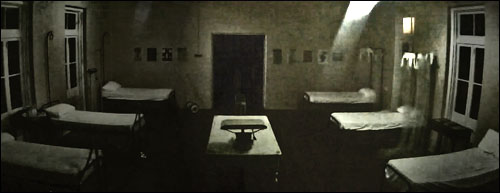
There are a number of things of which we should be be mindful as we begin to examine this event:
•Margaret did not know anyone on this tour, aside from her daughter. ((So she could have no idea of the bona fides of any other person there. For all she knew, everyone could have been in on a prank, except her and her daughter.))
•The photographs in question were taken on a phone and not a discrete camera (although Hugh’s story only specifies ‘camera’, this was one of the details I asked him to re-check with Margaret – it was a definitely a phone camera. This is a critical fact to know in considering certain aspects of the incident, as we shall see). ((It’s crucial to the ‘hoax’ hypothesis. Inserting a bogus photograph onto a standalone digital camera, whilst not impossible, presents some technical difficulties. Pulling off the same stunt on a phone camera is ridiculously easy.))
•The atmosphere on these ghost tours is highly charged, which I can verify from personal experience. People are skittish and jumpy. ((You will recall that, in my account of the Aradale tour which Violet Towne and myself took, I mentioned that other participants were certain they were experiencing supernatural phenomenon when there were far more likely explanations. And that tour was heavily tilted towards history, rather than the supernatural, so a more ‘ghost’ oriented tour is of course even more likely to imbue the proceedings with nervousness.))
•Margaret was predisposed to feel ‘a certain way’ about the location. She said to Hugh that “the place had a very sad feel to it. Not of danger, or anger, but sorrow.” ((This, of course, is a highly subjective and emotional assessment. Margaret presumably knew at least something about the place she was visiting, and even if she didn’t, her reaction is unsurprising; as a rule, ghost tours are not conducted in cheery, jolly, well-lit places. It kinda doesn’t work.))
•It is common that these kinds of tours are conducted by lantern light and there is often no other kind of light source. Margaret confirmed that this was the case on this tour. ((So photographs are going to be always in dim light, or by camera flash.))
•We like to think that other people won’t take advantage of our trust in them, but they can, and they will (for all kinds of reasons).
•People don’t, as a rule, remember past events particularly accurately, especially if they’ve witnessed them under emotionally enhanced circumstances. ((This is not merely an assertion on my part. There is substantial science in place that demonstrates that human memory is pliable and unreliable. In addition, skilled practitioners can exploit those factors very effectively.))
With those thoughts under consideration, I believe that – looking at it from the point of view of an impartial observer – there are six different possible explanations for this incident:
1: A woman on a nighttime ‘ghost’ tour of an old building actually snapped a realistic and unmistakeable picture of a ghostly apparition in the form of a sad baby, and was, completely understandably, deeply distressed.
2: The woman snapped a picture of something that a number of people, including Margaret and her daughter, mistook to be a ghostly baby.
3: The woman showed people a photograph she’d faked to appear as if it was that of a ghostly baby (and also fabricated a convincing emotional performance in an effort to reinforce its reality).
4. The woman herself was the victim of a hoax in which someone, somehow, planted an unsettling photograph on her phone without her knowledge.
5. The story of the ghost photograph incident was completely made up by Margaret, and related by Hugh as it was told.
6. The whole story was made up by Hugh.
Each of these scenarios has its own problematic consequence:
1: Asks us to accept the reality of a supernatural event, and furthermore, an event that numerous people failed to witness in actuality, but only saw as a result of some unexplained photographic mechanism. Explains the whole tale as told, but requires we question the nature of reality as science and rational endeavour reveals it.
2: Asks us to accept that numerous people were mistaken in exactly the same way by a photograph that Margaret describes as being as clearly of a baby as those of a normal human adult taken just before it. Explains the events, but requires we question the credibility and/or memory of a number of witnesses.
3: Asks us to accept that the woman concerned staged an elaborate prank. Explains everything, but requires a mechanism of execution for the deceit, and a motive.
4: Asks us to accept that someone else staged an elaborate prank, and was prepared to cause distress to carry it off. Explains the woman’s anguish and preserves her credibility at the expense of additional complication to the methods and motives for executing a hoax.
5. Asks us to consider that nothing Margaret told Hugh is true. Explains everything, but requires we question the credibility of the person relating the tale.
6. Asks us to consider that Hugh concocted everything, possibly including Margaret.
I don’t know Margaret at all, so I must maintain in my mind the possibility that explanation #5 is valid, since this and #6 are the ones that require the least number of assumptions. I do, however, know Hugh very well, and Hugh says he knows Margaret well, so I will accept that there is no real credible motive for Margaret to just spin a fantasy for Hugh, and then maintain that fantasy when queried on it. So I will discard #5 since there’s no compelling evidence to reinforce it (it is significant to note that, according to Hugh, Margaret herself is open to suggestions as to what she witnessed).
#6 is somewhat more problematic. Hugh knows me, and the other friends to which he told this tale, quite well, and it is within the realm of plausibility that he would play a complex trick on us. At this time, I have no way of knowing whether or not this is the case. I have only had the discussion about this affair via email, and Hugh’s emails seem consistent and don’t hint at any deception. I believe he is being truthful about this event, but rational process requires I must allow this as feasible. Everything considered, though, it seems unlikely, so I will disregard #6 also (I’m sure that both Margaret and Hugh find these last two options amusing, but I hope you can see that they must necessarily be part of the equation in order to cover all conceivable contingencies).
Of those explanations remaining, the one I’m most inclined to think is the most plausible at face value is #2: that people were mistaken about exactly what was in the photograph. And yet, Margaret seems adamant about what she saw: “The baby was as clearly there in the photo as the man in the others.” So, if she’s right about that, then we are faced with the two main remaining possibilities: that the photo is a genuine photo of a ghost, or that it was faked. ((For the purposes of this investigation, whether or not a hoax was perpetrated by Margaret or by a third party who ‘framed’ Margaret, is incidental.)) The easiest of those to examine from a procedural point of view is the feasibility of fakery; how hard would it be to concoct this kind of photo and insert it into a photostream on a phone without being detected? The answer is that it is not at all difficult, as I quickly discovered. It turns out that there are numerous phone apps that will allow the very quick creation of an archetypical ‘ghost’ photograph and save it to your photo library.
On Halloween, Violet Towne and I were booked on walking tour of Melbourne General Cemetery, so I decided to carry out an experiment: would I be able to take photos on my phone, and, unbeknownst to strangers on the tour, insert it into my photo library as if I’d taken it with my camera phone? The answer is that it was trivially easy. Here are two consecutive shots from my phone on that night. The second one contains the ghost:
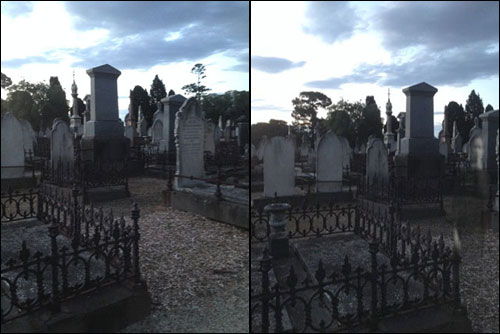
Although there were about twenty people on the tour, I was easily able to make it appear that I was casually photographing the graves while preparing and inserting a ‘ghost’ into my image. If I’d been so inclined (and of adequate acting ability) I could have, without any doubt, convinced people that this image appeared without my knowledge. ((I achieved this trick with Ghost Capture, an iPhone app that is designed specifically to make ‘ghost’ photos. It comes with a library of images that you can insert as your ghost, but also enables you to use any image you like as your phantom. Right now there are numerous images in circulation on the internet that purport to be genuine ghost photographs, but which a casual search reveals to be the work of this app, or one of another dozen or so just like it. It’s pertinent to understand that a user with even a little skill could contrive to use this app on a ghost tour such as the one in question to create in a matter of seconds a reasonable ‘double exposure’ style ghostly apparition.))
I emailed the image to Hugh, who remarked that it looked to him like a classic double exposure – which it does, indeed. He showed it to Margaret who concurred and said “Well that is pretty good and spooky but no, it looked like a normal photo of a baby – as though it had actually been sitting on the bed when the photo was taken.” I could have made my ‘ghost’ less transparent and more solid – at the expense of ‘ghostliness’ – but as Hugh quite correctly pointed out, that would have made it easier to detect as an added image, and more like a collage. In this instance, he said, lighting conditions and interaction with other things in the scene would become much more critical. All completely valid observations. But as a result of the reactions from Hugh & Margaret, I realised something quite crucial at this point: for my photo to have had maximal effect, I’d have needed to have made the ghost photo obvious as quickly as possible after I’d taken the shot. In this era of extreme pixel-pushing, almost everyone knows that you can easily stick a ghostly apparition into an image with Photoshop, so waiting a couple of days would certainly open up the possibility of that having been done. In addition to that, it’s much more effective to show people such a shot while they are primed to be expecting ghosts, and while their critical faculties are impaired by the frisson of the circumstances and are acted upon by group pressure.
The thing is, we also don’t really know how convincing the photograph was, since we don’t have it. Margaret says that the shot of the baby looked as real as the photos of the man on the bed, but how good were those shots, actually? They were taken by lantern light – that’s going to be pretty dim, even with each person on the tour carrying a lantern. ((I checked with Hugh about the lighting – Margaret made it clear that there was no light other than the twenty or so lanterns carried by tour members.)) Under what conditions did Margaret and her daughter view the images? How big was the phone screen, for instance? How long did she get to examine it? Who was in control of the phone – was she able to look for as long as she liked, or did the woman whisk it away from her ‘to show someone else’? Maybe the excitement of the incident clouded her perception and she remembered the baby to be more real-looking than it was? It’s hard to be sure of any of these things.
Even so, let’s go on and accept that the ghost photograph was 100% convincingly that of a baby sitting on the bed with its hand draped over the woman’s bag. ((And there’s another item we should consider. The bag was prominently identified in the story, both before the photograph was mentioned and then as a focal point in the ghost baby photo which showed, according to Margaret, “One of its hands… placed over the bag beside it”. The bag could quite conceivably be serving the purpose of magician’s misdirection prop, making you focus on something other than the thing you should be focussing on. It might, for instance, be distracting you from the fact that the photograph was taken on a different occasion, perhaps. Your eye is drawn to the bag on the bed, but not to the fact that it is a completely different bed, say. Because the bag is detailed so clearly in the story, it even makes me wonder whether the woman made a purposeful point of drawing attention to it. This kind of ploy is used in stage magic tricks all the time, in order to contrive a phantom continuity of events.)) Since no-one saw a baby there in reality, the photograph is plainly not a record of an actual real event that occurred at that time.
One thing we must consider, therefore, is the possibility that what was shown on the phone was a normal photograph of a real living baby on the bed taken at some other time in similar lighting conditions and then inserted into the phone photo library directly after the events in the dormitory had transpired. I checked to see whether I could do such a thing and found that it’s very easy to accomplish in a variety of ways. It just needs some basic iPhone knowledge and a little simple preparation. Anyone could do it.
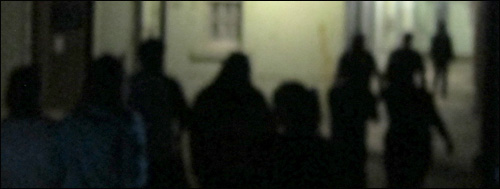
Now, let’s contrast that scenario with the other main alternative: that a digital phone camera captured, via mechanisms unfathomed and with a high degree of realism, a phenomenon that no-one present witnessed with their eyes; that is, the supernatural apparition of a baby with “a piercingly sad gaze”. I cannot categorically discount this, of course, not having been there, nor having seen the photograph. I will say, though, that it occurs to me that this image, if genuine, would be one of the most persuasive ghost photographs ever taken. To put it into context, if the photo was as realistic as Margaret remembers, and the events happened as she recalls, and there is no fakery going on, then there exists no other photographic record, at this level of verisimilitude, of any ghostly phenomenon ever. I’ve seen hundreds of photographs purporting to be of ghosts, and I’ve never seen a single one that was ‘realistic’, (except for photographs that have been offered up well after the supposed event, and are therefore distant from the memory and verification of any witnesses). What we would have here, then, is a photograph of a ghost witnessed by numerous people almost immediately after it was taken. This would be, to my knowledge, unprecedented. It is, in any event, extremely rare. Had I been the photographer, I’d have wanted as much endorsement of it as I could possibly get. I’d have immediately posted it to my Facebook page for a start, or if I wasn’t a Facebook user, I’d have messaged it to several trusted friends for verification and time stamp. The idea that our mystery woman was just too freaked out by it to make it more public than the people who were in her immediate vicinity just screams ‘setup’ to me.
I hope you will agree that of these two possibilities, the faking of the photograph provides a conceivable, and not particularly elaborate, explanation for the ghost baby image.
Of course we don’t have any evidence at all as to why someone would seek to carry out such a deception, but when faced with the other option, coming up with a motive for a hoax seems the lesser of two leaps of plausibility: perhaps the hypothesised hoaxers had no other intention than to freak people out; maybe they thought it would be funny for the people concerned, but it worked too well and they chickened out when it came to revealing the gag; it’s even possible that they just wanted to see if they could pull off a stunt of this kind for aesthetic reasons. Maybe it was a rehearsal for a much more complex scheme to be used for publicity purposes by the tour company. ((As there has been no mention of it on the tour site, one must assume that it has not so far been used with this intention.)) It could even be a bit of all of the above. These can only be speculations on my part, of course, but in my opinion even these speculations are more credible than accepting the alternative, which requires that we accept several supernatural mechanisms that have no basis in science or rationality. The main reason that Margaret herself is hesitant to accept the hoax hypothesis, is that she considers the distressed reaction of the woman who took the photograph to be far too convincing to be a performance. You can probably work out that if I can entertain the concept that Hugh, a person I know well, might be pulling my leg, I certainly have no trouble being skeptical of the motives of a woman who we know only as ‘the woman’ and whose photograph – the key piece of evidence in the whole adventure – remains, at this writing, unavailable for anyone to examine. ((I’m prepared to wager that if anyone attempts to pursue the photograph, it will never manifest. It will be either have been erased from the phone by the owner ‘because it was too disturbing’, or it will have mysteriously erased itself – vanished into the ether via the same supernatural mechanism by which it arrived.))
This has been yet another long post, but I hope you will agree with me that these kinds of stories are worth exploring in detail. Unlike many of the scammers and swindlers who we encounter on the Cow’s rambles, people who have been involved in events that seem genuinely puzzling and mysterious deserve, I think, consideration and respectful attention. I have, myself, had one or two of those experiences. At the same time, it is important to keep a very clear idea of how the landscape of such things is shaped. It is one thing to propose a mystery. It is an entirely different thing to propose that the solution to that mystery involves even greater mysteries, especially when there are far less mysterious solutions at hand.

